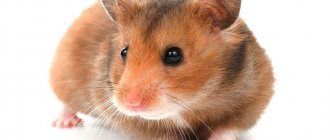Does a hamster need drinking water?
There is an opinion that hamsters are content with the liquid contained in vegetables and fruits. Some people conclude that a hamster does not need water at all. For what? Hamsters, as you know, live in the desert and make do with the water contained in their food. And the fact that dew falls every night in the desert and persists until sunrise is completely ignored by such advisers, just as the fact that there is no dew in a cage. So the animal needs to be given water, in addition to food, and you should not give the hamster super-properties; this warm-blooded land animal needs to drink.
Therefore, hamsters drink water; they must be provided with a fresh supply on an ongoing basis. You need to keep an eye on the drinking bowl, especially if water is given once every 2-3 days, or so that a situation does not arise when the drinking bowl malfunctions and leaks, and the animal begins to suffer.
Strictly speaking, it is better to give hamsters a drink every day, for example, after cleaning the cage - this way you can easily control the drinking bowl itself, and microbes that can cause inflammatory diseases in your pet will not begin to multiply directly in the water.
Causes of increased thirst
Heat
In a hot and stuffy room or in the sun, water is the only thermoregulation mechanism available to the rodent. Hamsters drink water to avoid overheating (heatstroke) and dehydration.
Pregnancy and lactation
During pregnancy, the female predictably begins to drink much more than usual. This is normal; under no circumstances should you limit your fluid intake.
Diseases
- Diarrhea
Regardless of the cause of diarrhea (poisoning, infection, poor diet), with indigestion the hamster loses a lot of fluid. Drinking helps restore the water-salt balance and is preferable to succulent food, which can aggravate problems with the gastrointestinal tract.
- Constipation
The opposite of diarrhea is the problem: dry food alone can cause stool retention, which is very dangerous for rodents. If a hamster has the opportunity to “wash down” food, this will prevent coprostasis.
- Diabetes
Excessive drinking and urination are the main signs of diabetes, to which Campbell's hamsters are so susceptible.
- Kidney problems
If your hamster drinks a lot and pees a lot, but the blood glucose level is not higher than normal, you can suspect diseases of the urinary system.
- Pyometra
If a hamster, when kept alone, begins to drink a lot, thirst indicates inflammation of the uterus (pyometra). The body thus tries to get rid of purulent intoxication.
Water container and daily dosage
A hamster needs easily accessible water. For this, a special drinking bowl or bowl is used. Any container is sold in pet stores and is presented in an assortment. The option with a bowl is not the best; the animal can easily pollute its water by throwing pieces of bedding in there or even turning it over. Then the floor in the cage will get wet, and the homa himself will not be able to drink.
Since the choice of special drinkers is large, it is more convenient to choose the option with a dispenser.
The daily dose depends on the breed and size of the hamster. And also on the microclimate in the apartment - how hot and dry it is in the house. It is generally accepted that these rodents require 10 milliliters of water per 100 grams of weight. This is 2 teaspoons.
Milk: good or bad?
Wanting to diversify the diet, many owners treat hamsters with milk. Experts say that pregnant and lactating females should be fed dairy products . During the period of gestation and feeding, the body gives off energy and requires renewal.
4-5 grams of dissolved milk powder should be given for the first three weeks after the birth of the cubs.
If the mother dies, newborn hamsters are hand-fed with infant formula. Also, support with milk is needed for individuals who have suffered from the disease .
It is recommended to give milk to healthy and active animals no more than once a week as a reward or treat:
- It is advisable to choose milk with a minimum percentage of fat content.
- Before serving, the dairy product must be boiled and cooled for better digestibility.
- Cream, kefir, butter and cottage cheese with a high percentage of fat should be completely excluded from the diet. Products with a high proportion of fat content aggravate stomach and liver diseases.
Article on the topic: Rating of the best food for hamsters (Djungarian and Syrian)
What kind of water can you give your hamster?
There are also discussions on this topic - whether you can drink from a tap or not, whether you need to freeze water and the like, which in itself is already surprising. A simple and reliable way is to drink clean water from a cooler or buy bottled water in a store. Half a liter bottle of water will last the animal for more than a month.
Questionable choice
Making a bad choice when deciding what water to give is choosing the tap option. Everyone knows that such water contains a lot of chlorine and other chemical compounds. This is easy to verify if you leave the water to settle. Within about a day, flakes and a suspension of settled contaminants will appear at the bottom of the vessel in which the water settles.
Sometimes there are recommendations to freeze tap water, and then defrost and drink this water. But such advice is similar to misconception, because if freezing kills microbes, then heavy chemical suspensions will not go away. And there are no microbes in tap water as such after chlorine.
Optimal choice
Therefore, the animal needs to be given clean water from a cooler or store. Another option is boiled water, and it is also allowed to stand for a day or longer. But considering how little water hamsters drink, it is still better to buy a bottle of regular purified water and add it to the drinking bowl. The water, of course, must be still.
How to accustom to a drinking bowl
Owners rarely encounter problems with drinking water, relying on their natural intelligence. The training procedure is much easier if the hamster knows the hands of its owner. It will be enough to show him the location of the drinking bowl several times, but if you only intend to get one, it is recommended to buy all the accessories in advance so that once in a new home, a curious hamster can explore every corner. Having stumbled upon the tip of the automatic drinker, he will definitely want to try it “by heart” and understand where he can get the vital liquid.
Small individuals sometimes simply do not know how to drink from an interesting device, and then the owner will have to help them master the home:
- The container is installed low so that you can freely reach the spout;
- leave your pet alone for a while, giving him the opportunity to master the drinking bowl on his own;
- If after several hours the hamster is still not interested in the device, then you need to pick it up and bring it to the tip. By touching it with his nose, he will feel the moisture and will be able to understand what the device is for.
It may take several attempts to fully learn the process, but do not force the hamster to drink - he must take the initiative himself and master his home.
If aggressive behavior occurs, you can use a trick - lubricate the tip of the drinking bowl with your favorite treat. Having smelled the smell, he will immediately run to the drinking bowl, and then taste it.
You cannot smear your drinking straw with products from the prohibited list, which include jam, honey or processed cheese.
Choosing a drinker
Arriving at the store, the buyer may encounter some difficulties when choosing a drinker. There are 2 types:
- ball, the functioning of which occurs after licking the ball at the tip of the tube. It rotates, the liquid goes into the mouth, but sometimes they often break. The ball stops spinning, as a result the hamster cannot drink;
- The reed type is designed differently; at the end of the tube there are 2 balls and a small vertical valve, when pressed, water will flow out.
The container itself should be transparent so that you can monitor the level, and the spout should be metal so that it does not get chewed off.
Dehydration: causes and symptoms
A hamster is very vulnerable to dehydration and will not survive more than a day or two on dry food alone. Here the question of whether hamsters need water is excluded. Dehydration can occur in several situations:
- Khoma worked hard in the wheel, and then he ran out of water;
- the animal is sick, its stomach is upset and there is diarrhea, then dehydration can occur, despite a full drinking bowl;
- the hamster escaped from the cage and wandered around the apartment, in which case he is also at risk of dehydration;
- the animal may get sick and stop drinking;
- your pet may have suffered heatstroke.
In any case, dehydration develops very quickly and can be fatal if the situation is not corrected.
Clean water is the key to your pet’s health
When choosing a drink for your pet, you need to consider some factors:
- Tap water is disinfected with chlorine dioxide. Even a minimal amount of bleach can harm a hamster's health.
- Boiling kills the presence of chlorine in the liquid, but increases the concentration of salts. Frequent consumption of boiled water can lead to diseases of the pet's genitourinary system.
- Rainwater or water from a pond must be boiled to destroy helminth eggs.
The optimal choice would be:
- Tap water that has passed through a specialized filter.
- Bottled water.
- Still mineral water with minimal levels of salts and trace elements.
- Melt water that has been deep frozen. The naturally thawed liquid does not contain harmful substances and is suitable for drinking.
How to spot the symptoms of dehydration
Symptoms of dehydration are easy to notice if you look closely:
- the homa will have sunken eyes;
- dry mucous membranes;
- the animal will be weak and lethargic;
- there may be difficulty breathing.
And in addition to the listed signs, the skin will become loose. The skin test is the fastest way to determine dehydration. You need to pinch and slightly pull the skin on the hamster's neck. If the skin immediately returns to its previous position, then everything is fine. If the skin lingers even for a short time in a raised position, the animal is dehydrated.
Bowl or sippy cup?
The daily drinking rate for a healthy rodent is 5-15 ml of water per 100 g of body weight . Using a bowl can cause constant tipping and puddles inside the cage. Litter, feces and food can also spoil the taste of the water if you use the bowl as a reservoir. The optimal solution for the animal is a water bottle.
A drinking bowl attached to the walls of the enclosure saves space and easily trains the animal to drink. When you press the valve or ball at the end of the spout, water drips into the rodent's oral cavity. Most animals determine the source of moisture themselves, but sometimes help is required. Just splash a drop of water on your pet's nose.
Important! To ensure uninterrupted access to liquid for the rodent, the water in the drinking bowl should be replaced daily, and in the summer, 2-3 times a day.
Hamster rehydration
If your pet is slightly dehydrated because he ran out of his cage for a few hours, you need to take care of the problem by refilling the water bottle so that he drinks as much as he wants.
You should not try to bathe your pet thinking that this will quickly restore it. Hamsters do not swim in nature. Bathing will be stressful for the animal, and it may catch a cold.
When you suspect your pet is severely dehydrated or you don't know how long he's been without water, it's best to contact your veterinarian. Indeed, in some diseases, especially with diarrhea, it is not the disease itself that quickly kills, but possible dehydration.
The veterinarian will administer a saline solution with salt and mineral supplements intravenously or subcutaneously to help restore the condition.
Preparing for the arrival of a hamster in the house
Although hamsters do not require care, it is still better for future owners of the animal to become familiar with its characteristics in advance. In addition, if you obtain complete information about the animal’s lifestyle in its natural environment, you can create suitable conditions for keeping the rodent at home.
Types of domestic hamsters
Before purchasing a pet, you should get to know the different breeds of hamsters to choose the pet that suits your taste. They differ from each other in size, color and behavior.
The most popular breeds:
- Syrian. These are the largest hamsters, whose body length exceeds 13 cm. They are easily tamed and do not get used to humans even after a break in communication. When caring for these rodents, one must take into account their reluctance to share territory with their relatives.
- Dzungarian. This is a dwarf species of hairy hamster. The body length is 8-10 cm. Djungarians have a light abdomen and a dark longitudinal stripe on the back. These cute animals are easy to tame, but they are hostile towards their fellow creatures.
- Roborovsky's hamsters. They belong to the dwarf species. The body size of an adult is 4-5 cm. Color is sandy yellow. Miniature rodents do not require complex care and get along well in pairs or groups.
- Campbell's hamsters. These are small hamsters 7-10 cm long. At home they can live either alone or in a group.
Djungarian and Syrian hamster
Campbell's Hamster
Roborovsky's hamster
Features of the animal
Caring for a hamster will become much easier if its owner takes into account the pet’s lifestyle and characteristics:
- This is a nocturnal animal. During the day he sleeps, and at dusk he comes out of hiding and goes about his business - storing food supplies, decorating the house, running. This means that during daylight hours it is rarely possible to see and play with a rodent.
- With good care, hamsters live 2-3 years.
- A rodent's teeth are constantly growing, so it must eat solid food to wear down its incisors.
- A hamster can die from severe fright, overheating, or hypothermia.
- These animals are very prolific. In one litter of a female there are from 6 to 16 cubs.
Pros and cons of content
Usually, parents decide to get a rodent for their children only because caring for it does not take much time. However, keeping a hamster has other advantages:
- the animal does not take up much space;
- the animal is inexpensive - from 150 to 300 rubles;
- you won’t need a lot of money to maintain and care for it;
- The hamster gives positive emotions and is interesting to watch.
Disadvantages include a short lifespan, noise at night and the appearance of an unpleasant odor.
Rodents bathing in the sand
Sand bathing is the safest and most natural alternative. The material cleanses wool well from stubborn dirt. During the bathing process, the pet experiences pleasure. The material is not capable of harming the animal.
For swimming you need to buy special sand. It must be intended for hamsters. You should not buy sand for chinchillas: it is fine-grained, so it can get into the animal’s respiratory tract. It also does a worse job of cleaning hamsters' fur.
A small amount of sand is poured into a container and placed in the cage. After this, the hamster will become interested in the new product and begin to bathe. After cleaning is completed, the container is removed. Otherwise it will turn into 2 toilets.
When is bathing necessary?
Before swimming, the benefits and risks are first assessed. If the first one outweighs, the procedures are carried out.
You can bathe your hamster in the following situations:
- The rodent got dirty in some food products. We are talking about foods that are prohibited and potentially dangerous for the hamster, such as mayonnaise, honey or jam. While such substances are on the rodent's fur, it can lick them off during the process of self-cleaning. In large quantities, the products will cause poisoning or death of the pet.
- The pet has stained its fur with chemicals. This is an even more dangerous situation. Most often, disinfectants and detergents end up on rodent fur. When they enter the stomach, they not only cause poisoning, but also injure the delicate mucous membranes of the gastrointestinal tract. The risk of developing chronic pathologies increases.
- The animal has parasites. Hamsters are sometimes bothered by parasites and mites. This happens rarely, but the chance remains. In this case, it is better to wash your hamster than to allow it to suffer from bites and risk infection. For the procedures, a special anti-parasite shampoo is used.
You can bathe your hamster if the rodent has gotten dirty.
Other possible diseases - kidney or pancreas
Symptoms very similar to diabetes occur with completely different ailments. Since these signs are quite similar to the diabetic profile, the disease can be excluded or confirmed by using the same test strips for determining sugar and acetone in the urine.
Sick kidneys
- the pet’s urine has changed its smell to a stronger one than before, there may be traces of blood in the urine;
- the animal’s mood has deviated from the norm - unreasonable activity or incomprehensible apathy has appeared;
- increased appetite, which is accompanied by weight loss.
If the measurement did not show any changes in either the sugar indicator or the acetone indicator, there is a possibility of inflammatory or other nature of kidney disease. The development of a tumor process cannot be ruled out.
Diabetes in hamsters. Diabetes Treatment Methods
Diabetes is an insidious disease that is found in many warm-blooded animals, including dogs, cats and even hamsters. This abnormal hormonal state is explained by the fact that the body cannot process sugar because there is not enough insulin (type 1 diabetes) or the hormone insulin itself does not work properly (type 2 diabetes). This leads to increased sugar levels in the blood and urine.
Diabetes in hamsters is more common in dwarf Djungarian hamsters, less common in larger Syrian (Central Asian) hamsters. Diabetes is especially common in Campbell hamsters (a Russian-Chinese hamster hybrid). Some studies have shown that diabetes in Campbell's hamsters has the signs and behavior of type 2 diabetes, although anecdotal evidence suggests that this subspecies has diabetes more similar to type 1. Scientists have differing opinions on this issue. Apparently, both options are possible. A stress factor can accelerate the course of the disease in susceptible animals, for example, in the event of a move or change of owner.
Why does a rodent drink a lot of liquid?
If your pet's need for water has sharply increased, and the hamster begins to drink a lot of liquid, then you need to think about a change in behavior.
- Changes in temperature and humidity in the room. The ideal temperature is considered to be up to +22 degrees. For favorable wakefulness, it is better to move the cage with the animal to a cool place.
- Damage to the drinking bowl. It is necessary to check the connections for integrity and replace them in case of leaks.
- Changing the diet or quickly introducing a new food. It is advisable to switch to a new type of food gradually. Adding salty foods can also be a source of thirst.
If there are no changes in the activity of the rodent, then the appearance of kidney disease and the development of diabetes are possible . The main signs are:
- Eating more food.
- Rapid weight loss or obesity.
- The ruffled pose of the animal.
- Irritability and increased activity.
- Increased sleep duration.
- Frequent urine discharge, possibly with the smell of nail polish.
When your hamster drinks the weekly amount of water, you must show the animal to a doctor and begin a course of treatment.
Article on the topic: Can hamsters eat fresh peas, beans and corn?
Diet for diabetes mellitus in hamsters
The diet of a hamster with diabetes should consist of more protein and fiber than in a regular diet, but the percentage of fat and carbohydrates should be reduced.
Any carbohydrates in the diet (as they should not be eliminated completely) should be in a less easily digestible form, such as oat bran, whole grains, pasta and brown rice. Unfortunately, today such special mixtures for diabetic hamsters are not produced on an industrial scale. Although some brands (Harry Hamster, Harry Hamster and Burgess, Dwarf Supahamster) make mixtures without added sugar. We recommend preparing your hamster mixture yourself. It is advisable to use flax, hemp, millet and oat seeds in mixtures. If the mixture suits the hamsters, their fur will become smooth and shiny, which will indicate improvement.
Djungarian hamster cage
To make the adaptation period easy and calm for your pet, be sure to equip it with a comfortable home. Now in a pet store you can buy any kind of cages for dzhungarikas, from the simplest and most budget ones, to “palaces”, which are not cheap. Let's look at the pros and cons of various cells.
Traditional cage with bars
This option is good because the hamster can actively exercise by climbing the rods. He will also be provided with a comfortable temperature and constant fresh air.
The main disadvantages are the noise that the pet will make in it at night, and dirt. Be prepared for the fact that while running and playing, the hamster will spread the filler all over the floor surrounding the cage.
Also, the cage is not suitable for those who have other pets. A cat or dog can easily get to the dzhungarik through the bars.
Aquarium
Many readers ask: “Is it possible to keep a dwarf in an aquarium?” We answer: “It’s possible. But there are also disadvantages to this option.”
In the case of an aquarium, the night noise of your pet will practically not bother you. But there are a lot of disadvantages: difficulty in cleaning, difficult flow of fresh air and lack of exercise.
Plastic house
Such a cage will become a real paradise for your dwarf!
Many pipes, manholes and secluded corners will provide him with an active and fun pastime. The only disadvantage of such a house is its high price. Remember that you can equip a simple cage yourself - it is much cheaper. Be sure to buy your pet a small house. He will be able to sleep, relax and hide in it, which will make his life much more comfortable. It is worth giving preference to a wooden house. They are less durable than plastic ones, but chewing on them is harmless.
Some hamsters happily live in hanging houses. They are perfect if the cage is small or very crowded. There are also thatched houses. It is not suitable as a main home. But if you are looking for something to pamper your dwarf, think about this purchase.
Read more about the correct cell in our article.
How to install?
Purchasing and making a drinking bowl is not the most difficult task. It is also necessary to properly attach it to the cage so that a playful pet does not spill water and damage the structure. Store-bought copies are usually equipped with special latches, which are very convenient to use in this case.
If the drinker has a hole in the lid for fastening, but there is no latch itself, this is not a problem. It can be made from a small piece of wire, bent along the edges to form peculiar hooks. You can also use thick rope.
The main thing you need to pay attention to is that the container is held firmly on the cage, and that the pet itself does not get hurt on the protruding edges of the fastening.
You can also secure the drinker using a large plastic cup. To do this, it is turned upside down, and a hole for a drinking bowl is cut out in it. You need to make a small hole on the side into which the tube is inserted. The structure is placed quite stably inside the cage; it can be placed in any free space.
The floor drinking bowl should be equipped with a weighting material, then an active animal will not be able to turn it over. However, you need to take into account that the tank will need to be washed quite often, so you should not secure it thoroughly. It would also be appropriate to place such a structure on a stand. In this case, less dirt will also get into the water, as a result of which it will be possible to change it a little less often.
The dangers of frequent bathing for hamsters
Frequent bathing greatly shortens the life of a pet. Hamsters don't like water. They are not adapted to stay in liquid, even if it is short-term. Their fur is not thick and dense enough for rodents to quickly warm up. The hairs are not covered with water-repellent secretion.
The protective layers of the skin are delicate, so even after drinking water there is a risk of health problems. Additionally, water procedures can cause injury.
Stress when immersed in water
Hamsters can't swim. For them, immersion in liquid is fraught with death, especially if there is no way to stand on their paws. In water, the animal loses control over the situation; it has no chance to escape without the help of its owner. For this reason, rodents become very nervous. They break out, bite and cling to clothing. Under extreme stress, a heart attack can occur. Even if the pet survives, sometimes after shock it refuses water and food, becomes lethargic, and hides in shelters. In severe cases, the rodent becomes exhausted and dies.
Risk of hypothermia
Hamsters are not adapted to swimming. Their anatomical features do not provide protection from liquids. Trying to wash your pet can result in hypothermia, weakened immunity and pneumonia. Some owners, realizing this, try to dry the animal's fur with a hairdryer. You can't do that. The device frightens the pet, which increases stress. Excessively hot air can cause injury.
Trying to wash your pet can lead to hypothermia.
Violation of the protective layer of the skin
Since hamsters in the wild do not have to deal with water often, the protective layer on their skin is delicate, unstable, and easily destroyed. The liquid partially washes it away, which weakens the animal’s immunity. Due to the lack of a protective layer, skin problems arise. There is a possibility of hair loss.
Bathing with detergents is the most dangerous, especially if we are not talking about a special shampoo for hamsters, but about human shampoo.
Possible injury
The animal, sensing danger, instinctively breaks out and bites. If the owner drops the pet, the latter will fall either into the water or onto the floor. In the first case, the rodent swallows water and may drown. In the second, there is a risk of damage to internal organs and the spine. This can lead to the death of the animal.











